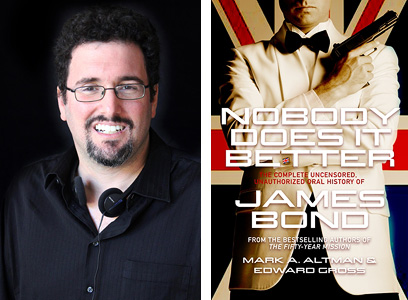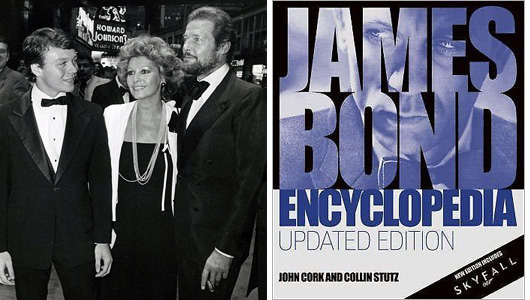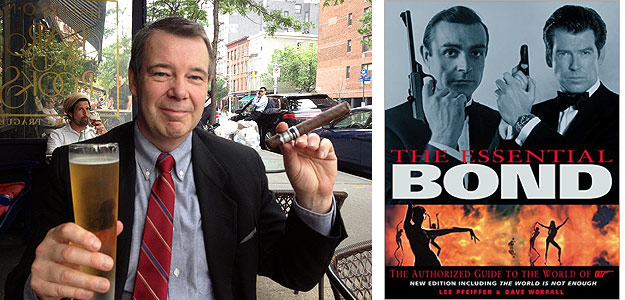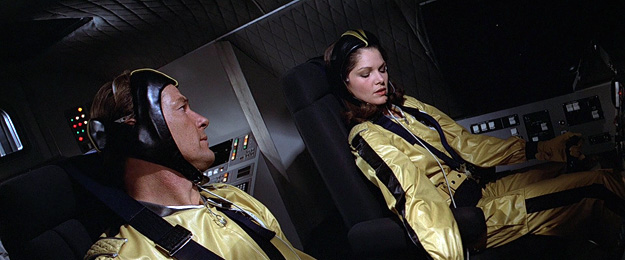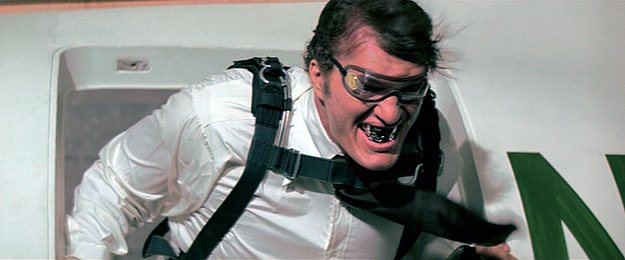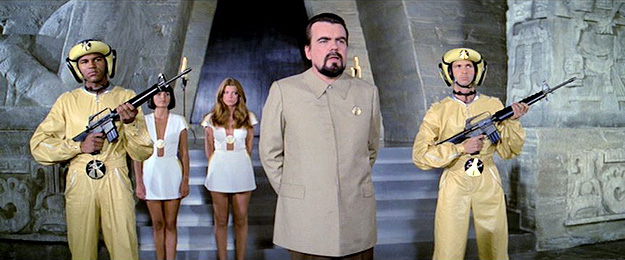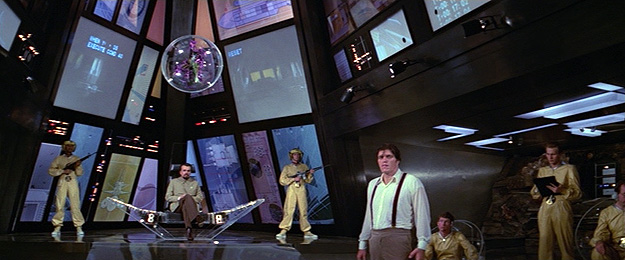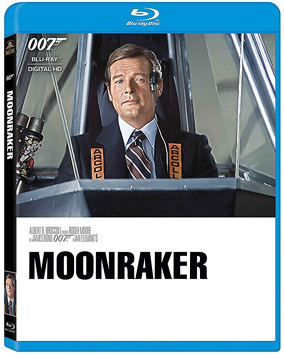The participants for this segment are (in alphabetical order)….
Mark Altman is co-author of the upcoming James Bond oral history Nobody Does It Better with Edward Gross from Tor/Forge which will be released in hardcover early next year. He is the creator and executive producer of the new sci-fi TV series, Pandora, which debuts on the CW and around the world, on Tuesday, July 16th at 8 PM, as well as a writer/producer for such series as Castle, The Librarians and Agent X and co-writer/producer of the romantic comedy Free Enterprise, starring William Shatner and Eric McCormack. Altman is the co-host of the popular podcasts, The 4:30 Movie (where he selected Moonraker as his pick for “In The Shadow of Star Wars Week”) and Inglorious Treksperts, the only podcast for Star Trek fans with a life. Other oral history collaborations with Edward Gross include So Say We All: The Complete, Uncensored, Unauthorized Oral History of Battlestar Galactica (Tor Books, 2018), The Fifty-Year Mission: The Complete, Uncensored, Unauthorized Oral History of Star Trek (two volumes; St. Martin’s Press, 2016) and Slayers & Vampires: The Complete, Uncensored, Unauthorized Oral History of Buffy and Angel (Tor Books, 2017).
John Cork is the author (with Collin Stutz) of James Bond Encyclopedia (DK, 2007) and (with Bruce Scivally) James Bond: The Legacy (Abrams, 2002) and (with Maryam d’Abo) Bond Girls Are Forever: The Women of James Bond (Abrams, 2003). He is the president of Cloverland, a multi-media production company, which has produced, among other projects, Value Added Material for home media releases (including several of the James Bond movies). Cork also wrote the screenplay to The Long Walk Home (1990), starring Whoopi Goldberg and Sissy Spacek. He wrote and directed the feature documentary You Belong to Me: Sex, Race and Murder on the Suwannee River for producers Jude Hagin and Hillary Saltzman (daughter of original Bond producer, Harry Saltzman). He contributed new introductions for the original Bond novels Casino Royale, Live and Let Die, and Goldfinger for new editions published in the UK by Vintage Classics in 2017.
Lee Pfeiffer is the author (with Dave Worrall) of The Essential Bond: The Authorized Guide to the World of 007 (Boxtree, 1998/Harper Collins, 1999) and (with Philip Lisa) The Incredible World of 007: An Authorized Celebration of James Bond (Citadel, 1992) and The Films of Sean Connery (Citadel, 2001). Lee was a producer on the Goldfinger and Thunderball Special Edition LaserDisc sets and is the co-founder and Editor-in-Chief of Cinema Retro magazine, which celebrates films of the 1960s and 1970s and is “the Essential Guide to Cult and Classic Movies.”
The interviews were conducted separately and have been edited into a “roundtable” conversation format.
And now that the participants have been introduced, might I suggest preparing a martini (shaken, not stirred, of course) and cueing up the soundtrack album to Moonraker, and then enjoy the conversation with this group of James Bond authorities.
Michael Coate (The Digital Bits): In what way is Moonraker worthy of celebration on its 40th anniversary?
Mark A. Altman: Moonraker, despite the many slings and arrows that have been shot at it over the years, is incredibly significant in many ways. First, it was an immensely profitable entry in the Bond canon and in many ways the biggest of the “bigger is better” Bond canon which includes You Only Live Twice, Die Another Day and Spectre. It’s probably the best example of mission creep in which the producers throw everything but the kitchen sink in a late era Bond actor’s oeuvre to try and top themselves and it rarely works out. Hence: the paragliding sequence in Die Another Day. That said, Moonraker is an immensely enjoyable film with some of the greatest set pieces in the series’ history despite being undercut by an abundance of unfortunate humor (to wit: the double-take pigeon) and one of the best and most lyrical of John Barry’s many magnificent scores. The other more intriguing nugget is it’s a great example of old-fashioned miniature works which was unique because it didn’t involve an optical printer and motion control, but rather multiple passes of myriad elements in camera and unlike the effects of a film like GoldenEye over a decade later (or Die Another Day two decades later) are utterly flawless. It’s also heartbreaking that this is Ken Adam’s last Bond movie. It’s probably his best looking film (with You Only Live Twice and Spy a close second) and none of the subsequent Bonds would ever reach the incredible highs of Adam’s genius.
John Cork: When you look at a seismograph record of an earthquake, you see the black lines jumping up and down off the center in a frantic and frightening way. Moonraker is like that. The highs are spectacularly high. The lows are soul-crushing. The rapidity with which the film oscillates from edge-of-your-seat awe to brow-slapping indignity is, in itself, an achievement. It was everything right and wrong with James Bond in 1979. Despite its nods to the women’s movement, it lasciviously embraces the creepy sexual imperialism of the Roger Moore era just as casually as it ham-handedly embraces crass product placement.
In many ways Moonraker feels like Eon’s attempt to move in on the territory tread by the 1967 Casino Royale. Vesper Lynd in that film has purchased Nelson’s Column from Trafalgar Square, whereas Drax has purchased the Eiffel Tower in Moonraker. The space battle plays remarkably well with the Bacharach track The Big Cowboys and Indians Fight at Casino Royale (anyone who wants to test this should start right as Bond hits the “gravity button,” and watch in wonder as the music ends just as Bond is raising his hands to shoot Drax). Both films feature villains who have personal spacecraft (or flying saucers), hunting scenes designed to kill 007, and villainous plots to repopulate the planet after instituting death on a global scale.
If this seems like a brutal indictment, it’s not. In spite of everything, Moonraker somehow works on its own terms. It is truly a Bond film that does not give a fuck. It is both the most cravenly commercial and the most punk rock of the Bond movies. It is both camp and serious, sometimes in the same scenes. It has some of the best in-camera effects and model work you are likely to see, and some of the worst back-projection of its era. Why celebrate it? Because if you were to show someone just one film that captures everything that ever worked and everything that ever did not work during the entire history of the Bond movies, Moonraker is that film.
But I dare anyone to just watch the film one time. It will haunt you. You will be drawn back to it. Someday, you will be finding yourself saying, “Take me around the world one more time.”
Lee Pfeiffer: The film was undoubtedly a major success at the box office and most of the critical notices were good, too — in some case better than reviews that had been afforded far superior Bond films. It seems non-demanding Bond fans liked the goofy humor though hardcore aficionados were appalled by the level of slapstick that had reverted back to Man with the Golden Gun levels.
Coate: What do you remember about the first time you saw Moonraker?
Altman: I vividly remember the photo of Roger Moore in the yellow spacesuit on the cover of Starlog and could not wait for Moonraker to come out. I had fallen with Bond movies when my parents took me to see The Man with the Golden Gun (okay, there’s no accounting for taste) and multiple viewings on the ABC Sunday Night Movie of the Connery Bond films, but it was really The Spy Who Loved Me that cemented my Bond obsession. In fact, I saw that movie more times than Star Wars in the summer of 1977. So by the time Moonraker was announced (supplanting the credited For Your Eyes Only), I couldn’t be more thrilled. Even though I had read the book after getting it from the library, I knew they were dramatically changing it for the big screen and couldn’t wait. I saw it at the Kings Plaza Theater in Brooklyn back when it was still a two-plex and remember enjoying it immensely, although not as much as Spy Who Loved Me. But even then the lack of grounded-ness and camp offended my sensibilities as a Bond fan, particularly since it was bookended by so many great sequences that often are overshadowed by the silliness.
Cork: Everything. I remember getting on the plane in Montgomery, Alabama, and flying first class to New York on United Artists’ dime. I remember the limo ride into the city, the check-in at the Warwick Hotel on Avenue of the Americas. I remember the limo ride to the theater with a member of the United Artists publicity department. I remember that a radio station in New York was actually playing The James Bond Theme in honor of the premiere when I exited the limo. I remember watching everyone enter the theater, including Frank Sinatra. And I recall being introduced to Roger Moore by the UA publicity man and posing for a couple of quick shots before entering the Rivoli Theater where Around the World in 80 Days played for two years.
I remember thinking as Bond tumbled out of the airplane that this was going to be the greatest film ever. And then, moments later, Jaws flapped his arms falling toward a circus tent. I felt my own internal seismograph plummet. I was for the first time in my short life, embarrassed for the filmmakers of a James Bond film.
To explain, I had, through a lot of chutzpah and good fortune, written a letter to United Artists that had gotten me invited, all expenses paid, to New York City for the film’s U.S. premiere. The publicity department at UA even let me attend the after party at Régine’s. There, I experienced my own personal highs and lows as I watched Brooke Shields and her female friend bop their heads in time to the dance music. I longed to ask her to dance (she was 14, and I was 17), but never worked up the nerve. I was, like Jaws, futilely flapping my arms against the gravity of my own insecurities. I did, though, work up the nerve to talk to Ken Adam and Richard Kiel, who both humored me with kind words in response to my questions.
It was, though, one of the greatest nights of my life.
Pfeiffer: I had secured tickets to an advance press screening at the Rivoli Theater in New York City. Usually, press screenings were held in screening rooms but Eon Productions and United Artists obviously thought that inviting members of the public in as well would help to impress critics that the film was a big success. The public couldn’t buy tickets so I assume they either won contests or were family members and employees of UA and their friends. They even had Richard Kiel and his family in attendance. The strategy worked. The overwhelming reaction was very enthusiastic. Meanwhile, those of us who were Bond purists were appalled. The Roger Moore films had finally found the right balance between humor and thrills with the previous movie, The Spy Who Loved Me. Now they had gone back to cringe-inducing jokes and scenes that would have fit in well with old Jerry Lewis movies. I think the enthusiastic reaction from the audience and critics made us even more concerned that Cubby Broccoli would simply keep dishing out the identical formula in future films. Many years later Cubby explained to me that, despite the success of the film, he received a lot of mail from hardcore Bond fans who pleaded with him to “bring Bond back down to earth” with a more realistic film. I have to give him credit for doing just that with the next movie, For Your Eyes Only.
Coate: In what way was Michael Lonsdale’s Hugo Drax a memorable villain?
Altman: At the time, I thought Michael Lonsdale’s Hugo Drax was a second-rate Bond villain, but I’ve come to appreciate him a lot more over time. His droll sense of humor (“Find Mr. Bond. See that some harm comes to him.”) is really quite delightful and different than a lot of the other Bond baddies. One of my favorite scenes in all the Bond movies is when they go quail hunting and after Bond misses his shot, nailing a would-be assassin in the trees, he disparages Bond by saying, “You missed, Mr. Bond” to which Roger Moore playfully replies, “Did I?” as the assassin drops from a nearby branch. It’s just so pitch perfect as is the stunning scene that immediately follows in which Drax dismisses the beautiful Corinne Dufour and dispatches his Dobermans to devour her. She runs through the forest chased by the hungry dogs to the strains of John Barry’s brilliant score and I think it’s just marvelous. Ultimately, I think Drax is somewhat diminished by the fact that he basically has the exact same motivation as Karl Stromberg in the previous film, and it doesn’t help that Moonraker is pretty much a remake of Spy Who Loved Me... in space. Although I do love when M and the Minister show up with Bond and are greeted by Drax who inveighs that he doesn’t get the British sense of humor. I’ve subsequently grown to love Lonsdale in so many films, perhaps never better than in John Frankenheimer’s Ronin, so my estimation of him has grown considerably since the first of many viewings which now probably numbers in the hundreds.
Cork: Lonsdale’s Drax wins the prize for the most insouciant Bond villain. He plays the entire film as if he had just been briefly woken from hibernation. When I watch the film, I find myself wondering about halfway through his somnambulant “here in the untainted cradle of the heavens” speech, who let this guy out of the opium den? Lonsdale can be a fantastic actor, bringing real menace to a role, but he looks like someone embarrassed to be there hoping that if he just speaks in enough of a monotone and doesn’t move, no one will notice him. You get a small taste of the villain he might have been during the final confrontation with 007 where a bit of the manic obsessive comes through. Yet, even there, the lingering delay in dispatching Bond allows Roger Moore enough time to smirk, slowly raise his hands, toss off a bon mot (and probably boil water) before shooting Drax with wrist dart gun. Had that gadget been used in the innumerable other scenes between 007 and Hugo, it would have saved us all a lot of trouble. My super-cut of the film would have Drax uttering the line, “James Bond. You appear with the tedious inevitability of an unloved...” and Bond would shoot him right at that moment with his wrist dart gun, leaving mankind to wonder what Drax would say to finish his half-baked idea. An unloved Village People song? An unloved creepy uncle? An unloved egg salad sandwich?
One of the ways one can tell what was lacking in this translation of Drax from Fleming’s novel is the repeated attempts to put a character closer to the literary Drax into a Bond film. Trevelyan in GoldenEye was based on Fleming’s Sir Hugo Drax, as was Gustav Graves in Die Another Day. That’s how robust Fleming’s Drax is, and how much was missing from the character in Moonraker.
Pfeiffer: Despite my criticisms of Moonraker, I look more favorably on its good elements today. Among them is the performance of Michael Lonsdale, who is generally dismissed as being bland and understated. In fact, I find his performance to be very amusing. He’s given some of the film’s wittiest lines and makes the most of them. I wouldn’t call him one of the most memorable Bond villains but he deserves more praise than he’s received.
Coate: In what way was Lois Chiles’ Holly Goodhead a memorable Bond Girl?
Altman: Lois Chiles isn’t a great Bond girl, but as a CIA agent-cum-astronaut, she is a resourceful one, and like Major Amasova before her is a big step up from the dreadfully vacuous and shrill Miss Goodnight in The Man with the Golden Gun. Chiles isn’t a great actress, but she’s incredibly sexy, although the name is trying too hard to be provocative when it’s just dopey. That said, she also has a wonderful way of cutting down Roger Moore’s double entendrés and sexist banter (“A woman?”) and, frankly, no one could credibly pull off the line, “Take me around the world one more time, James.” When I saw the brilliant James Brooks movie Broadcast News a few years later, I always wondered why Holly Goodhead left NASA, the space agency, for a life as a journalist.
Cork: Lois Chiles was one of the most beautiful women on the planet when Moonraker was made. The last shot of her looking up at Bond, sly grin, twinkling eyes, her perfect delivery of probably the best double entendré of 1979, perfectly establishes what is memorable about her. But from the first, I always sensed this underlying unease in Chiles as she played Holly and a sense of sadness and loneliness in her eyes. I think there are a lot of reasons for that. First, her character seems less than driven in her mission, doing things like strapping Bond into a centrifuge and then wandering off, sleeping with him in Venice after he sneaks into her hotel suit, then acting like he’s the last person she would want to see in Rio. It is a very ragged, uneven character on the page. Second, Lois has talked publicly about how little direction she was given, and on a big film like Moonraker, where the actors can’t be expected to see the full picture, that connection with a director is important. Third, the most importantly, Lois had a brother with whom she was very close who was ill with Hodgkin’s disease and getting worse during filming. Lois was a match for him to donate blood platelets, so a lot of her emotional energy was naturally focused on her family, and her desire to get back home so she could donate blood to help keep her brother alive. He died before Moonraker opened. After Lois shared that story with me, I watch her performance in light of the very real drama she was going through at the time. I think she did a fantastic job, particularly under the circumstances.
Pfeiffer: The character of Holly is somewhat underwritten. There isn’t too much for Lois Chiles to work with other than to look beautiful. In retrospect, though, the film was ahead of its time in presenting her as female action hero in an era in which that was a rarity. The character refutes the old criticism that Bond women were pretty but dumb. Holly graduated Vassar and excelled at NASA, which makes for a good one-liner later in the film. She’s both brave and brainy and Lois Chiles never slips into the helpless woman scenario, screaming “JAAAaaammmess” as was the case in some of the other films.
 Coate: Where do you think Moonraker ranks among the James Bond movie series?
Coate: Where do you think Moonraker ranks among the James Bond movie series?
Altman: I rank this movie on a totally different scale than the others. Albert R. Broccoli set out to capitalize on the success of Star Wars and that’s exactly what he did. It’s a weird amalgamation of Bond and the late 70s zeitgeist and it’s very much a product of its time and not quite a Bond movie. It’s silly and absurd and as far away from the grounded espionage of From Russia with Love as you can imagine and yet I’d be lying if I didn’t have a soft spot in my heart for this film. In fact, I watch it quite a bit. It epitomizes all the excess and silliness of the Roger Moore years, but that’s not necessary a bad thing. The teaser is one of the greats with the parachute dive in which Bond is literally thrown out of an airplane without a parachute and yet it ends with Jaws flapping his wings and crashing into a circus tent completely illustrating the schizophrenia inherent in this film which goes from 100 to 0 in mere nano-seconds. But any Bond film with a top-notch John Barry score, magnificent Ken Adam production design and skillfully directed by Lewis Gilbert, can’t be all bad. There’s more style here than in any of the John Glen films that follow and there’s some real tension in the Rio sequences and a crackling boat chase as well. And if you’re willing to grant the film its excesses, the last 20 minutes on the space station as Bond and the American cavalry have a laser gun battle with Drax’s minions in outer space, it’s a super entertaining lark. Not to mention, I’ve always been amused that the climax to Moonraker and Star Trek: The Motion Picture, which opened a few months later, are virtually the same and you certainly could argue that Moonraker’s is a helluva lot more interesting.
Cork: This is tough. The film has so many fantastic moments: the free-fall opening, the centrifuge, the dogs unleashed on Corinne, the amazing shuttle launch simulations by Derek Meddings, the destruction of the globes as Bond and Holly are skipping across the atmosphere in their shuttle. But it has so many moments that crush the spirit of Bond fans: the gondola hovercraft, the horrendous effects of Bond and Holly sliding down cables in Brazil, and a general lassitude that permeates the film. Out of 26 Bond films, including the ’67 Casino Royale and Never Say Never Again, I place Moonraker in slot number twenty-one. It’s something to watch if you have a few hours to kill in Rio, and you don’t samba.
Pfeiffer: I rank it among the bottom tier of films but I’ve grown to appreciate the expensive look and scope of the film. The special effects were very good for the day. It doesn’t make the mistake that Golden Gun did, which is presenting a rather cheap look to the production even though it cost a lot of money. Moonraker has style and it also benefits from a very good theme song and score by John Barry. It also represented the last Bond film that Ken Adam designed the sets for and they are suitably grandiose and impressive. I also liked the scene where Bond is trapped in the centrifuge, a rarity in the film because it isn’t compromised by silly comedic efforts. The movie does contain my single favorite Roger Moore Bond moment. It occurs when he calmly shoots that would-be assassin out of a tree, then calmly hands Drax his shotgun and doesn’t bat an eye as Drax’s chauffeur drive him to the airport. It encapsulated the aspects of Moore’s Bond that defined his interpretation so uniquely. I’ve even grown fond of the idea of turning Richard Kiel’s Jaws into a hero at the end, but the romantic nonsense between his character and Dolly is still dreadful to endure. Moonraker had the makings of a very good film and with judicious editing of about five minutes of screen time, it still could be. Many years ago, I knew someone who did just that by creating his own “improved” version of the film that eliminated the over-the-top slapstick elements and the obvious product placements. It was a crude concoction in the pre-digital age, but I do recall it played very well indeed.
Coate: What is the legacy of Moonraker?
Altman: This is the Bond film that “real” Bond fans love to hate. But to me, whatever its faults, and there are many, it’s incredibly entertaining. I’d rather watch Moonraker a hundred times than suffer through The Man with the Golden Gun, Never Say Never Again, Licence to Kill or the last hour of Die Another Day again. Obviously it had a profound effect on the Bond film series in that despite its success, Cubby Broccoli was wise enough to realize that the series needed to go “back to basics” to endure, a philosophy that has kept it alive for decades subsequently whether with The Living Daylights, GoldenEye or Casino Royale. Unfortunately, the same bloat seems to happen again and again with these films and if I’m going to watch a big, bloated, silly James Bond film, there’s no better one than Moonraker (unless you put Thunderball and You Only Live Twice in this category, which I don’t). Plus back in the days when Bond films came out like clockwork every two years (as they should), there’s always the old Ed Wood adage and hope, “Maybe my next one will be better.”
Shameless Bond plug: Finally, if you’re a Bond fan, you might want to check out my new sci-fi TV series, Pandora, which debuts in July on the CW. It not only features Judi Dench’s nephew, Oliver Dench, who’s brilliant, but several Bond movie veterans as guest stars including Maryam d’Abo, so I hope you’ll tune in. If you watch carefully, you may even see or hear some Bond Easter Eggs.
Cork: The legacy of Moonraker is the rise of Michael G. Wilson. After the film came out, he went to his step-father, Cubby Broccoli, and said the scripts needed to be better. He had been the brainchild behind the two greatest stunt sequences in Bond history, and Cubby and UA knew it, so Michael was given the keys to the kingdom. He was put in charge of working with Richard Maibaum on the next script, and Maibaum soon decided that he and Wilson should be a writing team. Wilson was in on every key creative decision, and every business decision, too. Michael G. Wilson is a smart, collaborative, no B.S. man who has three great talents that he brought to 007: he has a background in engineering, a background in law, and a great instinct for visually exciting filmmaking.
Additionally, Moonraker was part of the last great era of United Artists. The studio had been founded on the idea that filmmakers, not bankers and businessmen, should make movies. When Cubby Broccoli and Harry Saltzman made their deal with UA, the agreement was simple: as long as a filmmaker could stay on budget, UA would finance and distribute the film, but it would not interfere. But when Transamerica Corp., a holding company that originally owned Bank of America, decided to go on a diversification buying spree, and purchased UA in 1967, many worried the unique business model would change. It did. UA was just another division, like their charter airline business and Budget Rent-A-Car. Eventually, things became so bad that the entire executive brain-trust of UA resigned and formed Orion Pictures in 1978. “I just do not think they understand the motion picture business,” said UA exec Arthur Krim about Transamerica upon leaving. Cubby Broccoli remained. He had to. Harry Saltzman had sold his half of the James Bond rights to UA when he left in 1975. Although the executives left in January 1978, the deals they made with Woody Allen, Broccoli, and Sylvester Stallone produced record box office for the company in 1979. Unfortunately, the next year was filled with films greenlit by the new team. This included the massively expensive Heaven’s Gate, prompting Transamerica to sell UA off, starting a long, painful spiral that continues to this day. One hopes that the glorious days of UA in the 1960s and 70s can come again, but Moonraker and the other great UA films of 1979 marked the glorious end of a great studio run by visionary executives.
Pfeiffer: If the film has a legacy, it isn’t a particularly favorable one except to say that mainstream audiences and critics tended to like it and it was a financial success. The movie was inspired to cash in on the success of Star Wars. In fact, For Your Eyes Only was bumped back to the next film in order to accommodate Moonraker. I understand the financial reasons for capitalizing on the outer space craze but it bothered me that Bond was now following another franchise instead of being the franchise that was being imitated.
Coate: Thank you — Mark, John, and Lee — for participating and sharing your thoughts about Moonraker on the occasion of its 40th anniversary.
The James Bond roundtable discussion will return in Remembering “Licence to Kill” on its 30th Anniversary.
IMAGES
Selected images copyright/courtesy 20th Century Fox Home Entertainment, CBS-Fox Home Video, Danjaq LLC, Eon Productions Limited, MGM Home Entertainment, United Artists Corporation.
- Michael Coate
Michael Coate can be reached via e-mail through this link. (You can also follow Michael on social media at these links: Twitter and Facebook)

